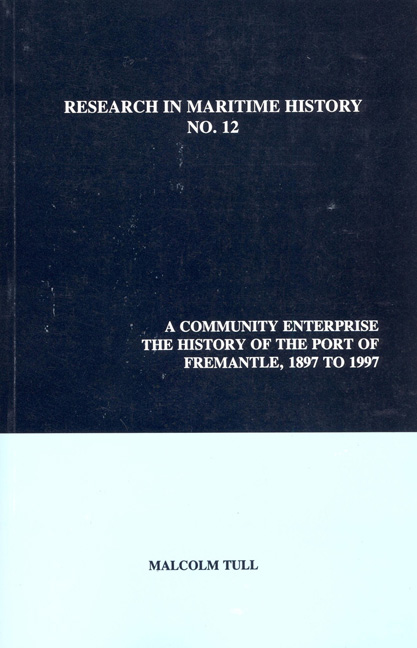Book contents
- Frontmatter
- Table of Contents
- List of Tables
- List of Figures
- List of Photos
- Acknowledgements
- Abbreviations
- Conversions
- Introduction
- Chapter 1 The Birth of A Modern Port
- Chapter 2 The Establishment of The Fremantle Harbour Trust
- Chapter 3 The Development Of Trade At The Port of Fremantle
- Chapter 4 The Shipping of Fremantle
- Chapter 5 A Century of Port Development, 1897 To 1997
- Chapter 6 Cargo-Handling Technology, Working Conditions And Industrial Relations on The Fremantle Waterfront
- Chapter 7 From Port Authority To Strategic Manager: The Transformation of The FPA
- Appendix A Trade and Shipping Statistics
- Appendix B Financial Statistics
- Appendix C Labour Statistics
- Appendix D
- Bibliography
- Index
Chapter 2 - The Establishment of The Fremantle Harbour Trust
- Frontmatter
- Table of Contents
- List of Tables
- List of Figures
- List of Photos
- Acknowledgements
- Abbreviations
- Conversions
- Introduction
- Chapter 1 The Birth of A Modern Port
- Chapter 2 The Establishment of The Fremantle Harbour Trust
- Chapter 3 The Development Of Trade At The Port of Fremantle
- Chapter 4 The Shipping of Fremantle
- Chapter 5 A Century of Port Development, 1897 To 1997
- Chapter 6 Cargo-Handling Technology, Working Conditions And Industrial Relations on The Fremantle Waterfront
- Chapter 7 From Port Authority To Strategic Manager: The Transformation of The FPA
- Appendix A Trade and Shipping Statistics
- Appendix B Financial Statistics
- Appendix C Labour Statistics
- Appendix D
- Bibliography
- Index
Summary
The beginning of modern harbour management and control can be traced back to Britain in 1857 when the Mersey Docks and Harbour Board was formed. Subsequently, similar forms of organisation developed throughout the British Empire. Melbourne acquired a harbour trust as early as 1876. The creation of the Fremantle Harbour Trust (FHT) in 1903 marks the establishment of formal port administration at Fremantle. The Fremantle Harbour Trust Act was largely based on The Sydney Harbour Trust Act of 1901 and a New Zealand Act of 1878. Throughout Australia, a large variety of port authorities have evolved with varying powers and systems of control, reflecting the impact of a multitude of factors, including geography, the nature of the hinterland, the type and volumes of cargoes, and national and state politics. By the 1960s there were about ninety major ports in Australia administered by thirty-five different sorts of authorities: “a system that grew up topsy-turvey from the days of pioneer settlement and sailing ships communications, developed during the days of State separatism and regional pride and jealousy and was never consolidated when the fragments became the Commonwealth.” The FHT is, however, of special interest because it acquired the power to engage in cargo handling operations, a profitable task usually left to private enterprise.
The Formation of the Fremantle Harbour Trust
The departure of the Premier, John Forrest, for federal politics in 1901 led to a short period of political instability that delayed attempts to reform port administration. However, in July 1902 Walter James’ Government assumed office and the following month the Colonial Secretary, the Hon. W. Kingsmill, introduced a bill in Parliament designed to establish a harbour trust at Fremantle. After considerable debate over the details of the bill, it was passed on the 11 December. From 1 January 1903 The Fremantle Harbour Trust Act vested exclusive control and administration of the harbour in a body corporate, the Fremantle Harbour Trust, with common seal, power to hold land and perpetual succession. Although some modifications have been made to cope with changing circumstances, the Fremantle Harbour Trust, renamed the Fremantle Port Authority in 1964, continues to guide the destiny of the port to this day. Such longevity suggests that the 1903 Act must have incorporated sound principles of port administration.
- Type
- Chapter
- Information
- A Community EnterpriseThe History of the Port of Fremantle, 1897 to 1997, pp. 27 - 50Publisher: Liverpool University PressPrint publication year: 1997



